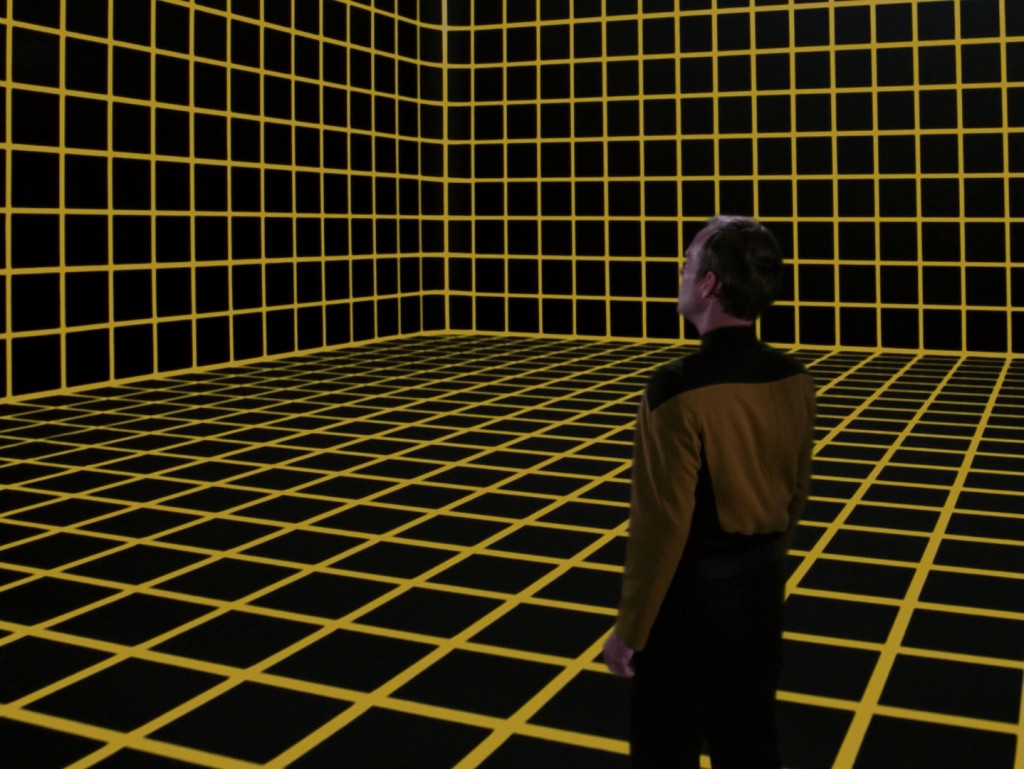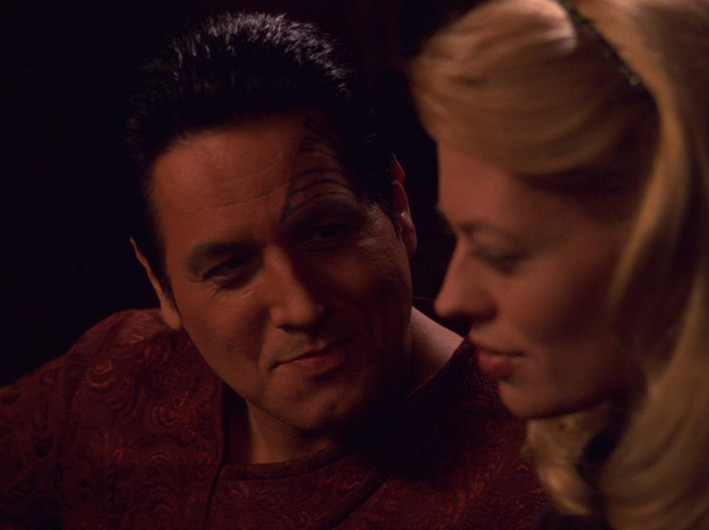Star Trek is an enormous and complex cultural entity whose impact on politics, technology, and storytelling are undeniable. It’s also as flawed and problematic as any other massive media franchise. Lifelong Trekkie and Deadshirt Editor-in-Chief Dylan Roth attempts to make sense of it all for die-hards and outsiders alike in his bi-weekly column: Infinite Diversity.
WARNING: The following installment of Infinite Diversity includes adult content, language, and rampant, non-canonical speculation.
The future of Star Trek is an astounding vision of humanity that’s evolved beyond selfishness, greed, bigotry, and hostility. The knowledge of life on other worlds led to human beings setting aside cultural or ethnic differences. The development of new technology like replicators made hunger and capitalism things of the past. New medicines wiped out most disease. Warp drive opened up an entire galaxy of exploration. Throughout the canon of Star Trek, these achievements are said to have made a near-perfect society possible.
But there’s one more important development whose nature is only implied, but could account for an incredible amount of social growth and evolution for the human species, allowing humanity to overcome one of its most universal challenges.
I’m talking about Sex on the Holodeck.
While a prototypical version of a holographic simulator appeared in Star Trek: The Animated Series, the holodeck made its first full appearance in the series premiere of The Next Generation, and remained a staple of the franchise throughout the TNG era. The holodeck is a big empty room that, through the mixture of hard light and replicated matter, can become a perfect facsimile of any location, and populate that space with lifelike, interactive holographic people. The holodeck has many practical purposes, but it’s typically used for recreation, a way for officers, crew, and their families to combat cabin fever while living in an enclosed space for years at a time. It’s also one of 24th century society’s chief forms of entertainment, with a wide variety of games and interactive stories (called holonovels) to choose from.
But like any medium in the history of entertainment—from print to film to the internet—it’s also used to get your rocks off.
The holodeck allows the user to custom-build any setting, even one not possible in the physical world, and also any person, even one who doesn’t exist, who will do whatever the program dictates. How long do you think it took the holodeck’s inventors to figure out the technology’s pornographic applications? (If nerds in the future are anything like nerds now, it was probably the initial purpose rather than a byproduct.)
It certainly didn’t take the writers of The Next Generation very long to present the audience with that potential. While the first few appearances of the holodeck demonstrated only a limited capability to represent small spaces and simple characters, by the mid-season episode “11001001,” the holodeck had gotten an upgrade, and Commander Will Riker became enamored with a self-aware holographic woman named Minuet, who heavily implied that sex was a possibility.
“How far can this relationship go? I mean, how real are you?”
“As real as you need me to be.”
Riker and Minuet, “11001001” (TNG)
Though the episode’s ending implies that the holodeck’s upgrade is only temporary, future stories show the holodeck and its characters reaching the same or even greater levels of sophistication. From this point in the series, the use of the holodeck for sexual purposes became more and more heavily implied, and eventually outright overt (to the extent that a mostly family-friendly show could present). By the time we reached Deep Space Nine, the holodeck (or holosuite, as it was called here) was referred to in a sexual context more often than not, as bartender Quark enticed his paying customers with programs sporting provocative titles like Vulcan Love Slave.
But how does virtual sex contribute to creating a social utopia, you ask? Much in the way that replicators level the economic playing field, making resources practically limitless and rendering our present economic models obsolete, so too would the holodeck change the way a society deals with sex. The quest for sexual satisfaction is one of the driving forces in the lives of most individuals, and has led to, among other things, the subjugation of one gender by another. The patriarchy is an institution that limits women’s ability to control their own lives so that men can more easily assert their power over them for their own sexual gratification. Sex isn’t an evil thing, but a great deal of evil has been perpetrated by both men and women (though mostly men, let’s be real) in the name of lust.
Now imagine if you didn’t need another person to have sex. I’m not talking about masturbation, I’m not talking about an approximation of sex, I’m talking about sex, all of it, from start to finish, in whatever form you like, whenever you like, with a partner that you design. Someone who likes the things you like, has the physical features you enjoy, with whom there are no lasting consequences. You could play out your every sexual fantasy, no matter how weird or implausible, without the need to ask anyone else to step outside of their comfort zone. It would change the very nature of sex, and the way that the sexes interact with each other.
In the entire TNG era, we almost never see two human beings engage in a relationship that is purely sexual, unless they’re being influenced by some mind-altering force. We don’t encounter blatant sexism or the objectification of either gender (by the characters; the show’s creators do it plenty). I’m hard pressed to think of any example of one human character pursuing another purely out of sexual interest in a story set after the beginning of TNG. People do have sex, but usually as part of a more serious relationship, or a good-natured fling on a vacation or something to that effect. When the physical gratification of sex is only a holodeck program away, there’s no reason to pursue sex for any reason other that you like someone. The purpose of real-life sexual encounters could become more about the expression of romantic love, a communication between partners, rather than two people scratching an itch, as it so often is.
In other words: why treat a person like a sex object when there’s a perfectly good sex object right over there?
The ability to indulge oneself sexually without a partner would also alter what individuals look for in a relationship. The level of sexual interest between prospective life partners would become a less important factor in the world of dating, leading to a less superficial society as a whole. There are plenty of great things about monogamous marriage, but it’s also built on the ludicrous assumption that any two people can continue to be sexually attracted to each other for their entire lives. Keep in mind that, in the world of Trek, people can live to be 140 years old. The ability to blow off steam with a holographic partner could help save longer relationships. Real-life couples could also abscond to the holodeck together, to spice things up with exotic locales and situations, and indulge in fantasies together more easily than in today’s world. We see the holodeck used as a date spot in all three TNG-era series, presumably for that purpose.
There are certainly be some drawbacks to a society that depends on technology for sexual release, first and foremost being dependency. This is something Star Trek actually tackles directly, most famously with the character of Reg Barclay. Barclay suffers from holodeck addiction, which exactly what it sounds like: he gets so wrapped up in his holographic fantasies that he can barely function in the real world, preferring the manufactured relationships that he has with imaginary people to flesh-and-blood people who can judge and reject him. It’s the equivalent of your friend who spends all of his time playing World of WarCraft, if none of the other players were real people. It’s life on Easy Mode, where there are no real consequences and no anxieties, and you can always start over if things go your way. This isn’t a problem that directly relates to sexuality, but sexuality could definitely make it worse.
Sexual adventure on the holodeck is only harmless if nobody’s feelings are hurt, so it also requires that players (for lack of a better word) not get attached to a program the way they would a real person. Otherwise, they’d might as well be having a real affair, and their real-life partner would have cause to get real-life pissed. It has to be masturbatory, otherwise it’s the futuristic equivalent of becoming obsessed with a porn star, with the added creepiness that you can actually make the porn star fall in love with you.
This, too, isn’t a problem exclusive to sexual relationships. Enterprise-D Chief Engineer Lt. Commander Geordi La Forge fell in love with a holographic representation of engineer Leah Brahms, a program who was only intended to make interfacing with the ship’s computer a little easier. It caused some real problems when La Forge encountered the real life Brahms and assumed that they’d get along just as well. Not only did they not hit it off, their relationship was initially adversarial, and made all the worse when Brahms discovered that La Forge had been spending time with her holographic counterpart. (We never get any on-screen indication that La Forge and Holo-Brahms had a physical relationship, but Brahms’ reaction implies that she at least believes they did.) It’s also established in Deep Space Nine that it’s illegal to use someone’s holographic likeness without their consent, for this exact reason.
There’s an additional concern, as well, because holoprograms are capable of becoming self-aware, either intentionally or due to being kept on for too long. This essentially makes them sentient beings who have the right to make their own choices, and shouldn’t be treated as anyone’s plaything. This, too, isn’t a problem specific to sex, since it would be just as bad to use a sentient holodeck character in your action-adventure program against its will. While a storyline in Voyager involves winning rights for sentient holograms, it’s safe to say that holonovelists and programmers take safeguards to keep their characters just characters, instead of evolving into fully-fledged people.
You might be asking yourself: “if holodecks can do all this, then why would anyone get involved in a real sexual relationship to begin with?” For the same reason a generation that has access to unlimited free music has started buying vinyl records. Real is better. The holodeck can fulfill all your lustful fantasies, but it can’t love you back. It won’t be there for you when the power goes out. This is precisely how holodeck sex saves the future: it highlights the importance of real human passion, of true romance, or true partnership. Love is not about sex, and in a future with unlimited hot and cold running sex, that’s more clear than ever. The replicator is the cure for greed, the holodeck is the cure for lust, and the result is a better human race that’s better able to circumvent sex and just value each other’s hearts and minds.
In theory, anyway. Sexual revolution or not, the gender politics of the Star Trek universe are still pretty damn lopsided, not because of the rules of the fictional society, but due to the shortcomings of the present-day creators. BUT THAT…IS ANOTHER STORY…
Infinite Diversity will return in two weeks! Follow @DeadshirtDotNet on Twitter to keep up with what’s new here on Deadshirt, and feel free to tweet @DylanRoth with suggestions for future topics for Infinite Diversity, or just to talk about Trek. He truly never gets tired of that.







It’s not something that could readily be shown on the show, though I’m sure many a fan assumed it was happening, but you make a very interesting point with the comparison of the holodeck and the replicators in terms of dealing with our vices. There are safety protocols in place, but the holodecks could also potentially deal with our violent nature (you do not talk about Holodeck Fight Club) as well. TNG really did figure out this utopia business. Mostly…